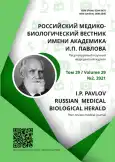Pathophysiological mechanisms of resistive breathing
- Authors: Byalovsky Y.Y.1, Rakitina I.S.2
-
Affiliations:
- Ryazan State Medical University
- Ryazan Statе Medical University
- Issue: Vol 29, No 2 (2021)
- Pages: 219-226
- Section: Original study
- URL: https://bakhtiniada.ru/pavlovj/article/view/34788
- DOI: https://doi.org/10.17816/PAVLOVJ34788
- ID: 34788
Cite item
Abstract
AIM: This study aimed to explore the pathophysiological mechanisms of resistive breathing by using a model of a conditioned respiratory reflex to external resistance to breathing.
MATERIALS AND METHODS: Inspiratory resistive loads were used 11, 28, 54, and 78 cmAq/l/s to model a conditioned respiratory reflex. External respiration was parametrized on the basis of the analysis of motor and ventilatory outputs. Conditioned signals were pure sounds exceeding the threshold of perception by 10 db at 2000 Hz frequency. All the test persons were divided into two groups (large and small groups) according to the initial reinforcement value. (1) In the large group (37 individuals), the conditioned reflex was formed from 11 cmAq/l/s that was subsequently increased stepwise in the load to 76 cmAq/l/s. (2) In the small group (18 individuals), the initial reinforcements were different gradations of resistive loads, with a stepwise transition to the other parameters of an unconditioned stimulus. The period of the isolated application of a conditioned signal (CS) was 20 s, the interval between signals was not fixed, varying from 2 min to 4 min. Six to eight combinations of the conditioned and unconditioned stimuli were used for 1 day of the experiment.
RESULTS: The increase in the added respiratory resistance was associated with the pronounced reduction of pulmonary and alveolar ventilation, that is, with the hypoventilation type of resistive load realization. Changes in ventilation during the isolated application of a conditioned signal had an alternative character. In particular, as the reinforcement factor increased, a pronounced shift to hyperventilation was noted.
CONCLUSION: The reinforcement value of the conditioned reflex changed stepwise, thereby significantly restructuring the proportion between the effectiveness of the adaptive activity in the realization of external resistance to inspiration (the time of stay under a certain load) and its physiological cost (totalities of the deviations of physiological and energy parameters).
Full Text
##article.viewOnOriginalSite##About the authors
Yury Yu. Byalovsky
Ryazan State Medical University
Author for correspondence.
Email: b_uu@mail.ru
ORCID iD: 0000-0002-6769-8277
SPIN-code: 6389-6643
Scopus Author ID: 8539156800
ResearcherId: E-1192-2014
http://www.researcherid.com/rid/E-1192-2014
MD, Dr.Sci(Med.), Professor, Head of the Pathophysiology Department
Russian Federation, RyazanIrina S. Rakitina
Ryazan Statе Medical University
Email: b_uu@mail.ru
ORCID iD: 0000-0002-9406-1765
MD, Cand.Sci.(Med.), Associate Professor of the Pathophysiology Department
Russian Federation, RyazanReferences
- Chuchalin AG, editor. Respiratornaya meditsina. 2nd ed. Moscow: Litterra; 2017. Vol. 3. (In Russ).
- Petrash AA, Sotnikov AV. History of tracheal intubation: from first mentions to modern thoracic anesthesiology. Russian Journal of Anaesthesiology and Reanimatology. 2018;(3):33-40. (In Russ). doi: 10.17116/anaesthesiology201803133
- Hehua Z, Qing C, Shanyan G, et al. The impact of prenatal exposure to air pollution on childhood wheezing and asthma: A systematic review. Environmental Research. 2017;159:519-30. doi: 10.1016/j.envres.2017.08.038
- Byalovskiy YuYu, Bulatetskiy SV. Fiziologicheskiye mekhanizmy rezistivnogo dykhaniya cheloveka. Voronezh: RITM; 2018. (In Russ).
- Byalovskij YuYu, Abrosimov VN. Pnevmaticheskij dozator vneshnego soprotivleniya dyhaniyu. Patent RUS № 2071790. 20.01.1997. (In Russ).
- Aleksandrova NP. Mekhanizmy kompensatornykh reaktsiy dykhatel’noy sistemy na inspiratornyye rezistivnyye nagruzki [dissertation]. Saint-Petersburg; 2003. (In Russ).
- Lin SL, Chang HC, Wu CL. Simulation of Mechanical resistive Loading on an optimal Respiratory Control Model with Added Dead Space and CO2 Breathing. Applied Mathematical Modelling. 2017;47:796-810. doi: 10.1016/j.apm.2016.10.029
- Segizbaeva MO, Aleksandrova NP. Inspiratory Muscle Resistance to Fatigue during Exercise and Simulated Airway Obstruction. Fiziologiya Cheloveka. 2014;40(6):114-22. (In Russ). doi: 10.7868/s0131164614050130
- Byalovskiy YY. Conventional respiratory reflex to increased respiratory resistance as an experimental model of adaptive activity. I.P. Pavlov Russian Medical Biological Herald. 2012;(2):75-84. (In Russ).
- Segizbaeva MO, Aleksandrova NP. The evaluation of inspiratory muscle function by measuring of «tension — time» index. Ul’yanovskiy Mediko-Biologicheskiy Zhurnal. 2014;(2):78-84. (In Russ).
Supplementary files












